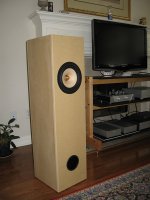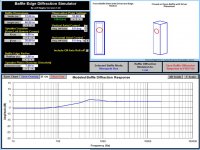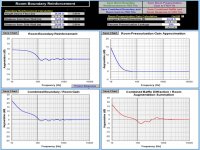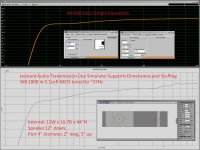Depth can be quite large but would like to keep width to 14" or less
OK, then a tall, narrow, deep cab = BSC required, so up to 6 dB of dynamic headroom is lost since they’re not close enough to the walls, corners, though usually it’s 2-3 dB unless well away from all boundaries in a large room.
BSC calculation, etc., here or if you have a good 1/3 octave equalizer..........: http://www.quarter-wave.com/General/General_Articles.html
GM
Last edited:
So by your design I would have inside dimensions 63"h x 15" d x 13" w. The driver would be 21" center to top and port 9" from bottom. Not sure how to tune port to 32 Hz?
Also, what does it mean to "rely on critically damping the vent"?
Yes, though this doesn’t account for the bottom plate + fairly massive base to make it stable, so allowing ¾” bottom plate and 1.5” for the base = 2.25” for this; I had come up with a 39.75” driver/bottom [i.d.] and using MJK’s preferred 0.349 offset, a 61.06” [id.] height with a ~golden ratio 11.06” x 17.94” cross sectional area [CSA] with the 5” dia. [or ~19.635”^2 square, rectangular equivalent area] vent either ~12.25” or ~8.75” [i.d] from the bottom plate.
That said, the wider the baffle the lower the baffle step frequency, so with a 14” limit [12.5” i.d.], a 1.27 ratio is an acceptable acoustic ratio, so depth = 15.875”.
Calculating the length of the vent is problematic for higher math challenged folks like me and for all these I built/tested, I could never figure out a simple ‘rule-of-thumb’/’fudge factor’ to know how much to shorten it from a BR’s relatively simple vent calculation, so would start with the BR’s length, which tunes it too low, and shorten it as required if it was unacceptable. In room though, they usually performed fine, so only shorten a few sets where the cab length was extra long IIRC at this late date.
MJK’s software and I assume AkAbak can calculate it, but I don’t have either loaded on this old laptop, so unless someone here helps out……….. Anyway, ~1.75” is the BR length for my recommended ~35 Hz tuning [~27.5 Hz usable output], though from dim experience I’m thinking a baffle thickness hole will be close enough and one reason why I chose the 5” dia..
BR cabs are 4th order alignments, so they ‘ring’ with compromised transient response, ergo it ideally needs to be damped and once it no longer ‘rings’ it’s deemed to be ‘critically damped’. Any extra just further reduces vent output.
We use to do it with a switched battery tester [AKA ‘click’ test], but nowadays with all the freeware measurement tools, just use an impulse to test when the right amount of damping has been applied, which historically were pieces of cloth, insulation, coffee filters, etc., tightly stretched over the vent.
At least some manufacturers choose [chose?] speaker grill cloth or foam with a ‘close enough’ acoustic resistance or use foam plugs in the vent or just add more damping in the cab. DIYers have been known to literally ‘stick a sock in it’
MLTLs when long and acoustically large enough [such as yours] to significantly reduce vent length is normally already well damped, so only needed to do it on some loaded with higher Qt drivers than one would normally use in a vented alignment.
GM
I wonder if an 1808 tapped TL or TH might somewhat preserve the tonal balance except with acoustic BSC.............
I suggested this 'crazy' idea many years ago using Pioneer B20FUs in a [necessarily huge] BIB except with a second one 'tapped in', but none tried it and I was [still] in no position to do it and now all my B20's surrounds have turned to a fine powder.
GM
I suggested this 'crazy' idea many years ago using Pioneer B20FUs in a [necessarily huge] BIB except with a second one 'tapped in', but none tried it and I was [still] in no position to do it and now all my B20's surrounds have turned to a fine powder.

GM
A nice 101 video for starters.
https://www.youtube.com/watch?v=pF7N8u9u3rc
https://www.youtube.com/watch?v=pF7N8u9u3rc
1) Room gain... why you may be satisfied with a 48" high 80l - 100l MLTL
2) Doppler distortion... why full range MLTLs excel at live music and can disappoint at home theater BOOM-BOOM.
3) W8-1808 Xmax~ 4mm... why most home theaters favor 3-ways with real woofers
1) Before you start building a 73" tall cabinet, download a couple of the free room simulators to model speaker placement vs. room gain in your HT space. A few room sims might convince you that a 48" high 40Hz MLTL with 80l - 100l internal volume can provide good low bass.
Baffle Edge Diffraction Simulator
By Jeff Bagby Version 1.20
Room Response Calculator v0.6d
by Yavuz Aksan
==============
2) Doppler Distortion... A full range speaker mixes high frequencies "riding" upon a bass frequency moving cone, and this produces Doppler distortion. A free Doppler simulator will show very high distortion when an 8" is run full range above modest SPLs.
3) The W8-1808 has an underhung motor which starts to generate Xmax distortion ~4mm on 220 sqcm cone. ~94db max at 40Hz
2) Doppler distortion... why full range MLTLs excel at live music and can disappoint at home theater BOOM-BOOM.
3) W8-1808 Xmax~ 4mm... why most home theaters favor 3-ways with real woofers
1) Before you start building a 73" tall cabinet, download a couple of the free room simulators to model speaker placement vs. room gain in your HT space. A few room sims might convince you that a 48" high 40Hz MLTL with 80l - 100l internal volume can provide good low bass.
Baffle Edge Diffraction Simulator
By Jeff Bagby Version 1.20
Room Response Calculator v0.6d
by Yavuz Aksan
==============
2) Doppler Distortion... A full range speaker mixes high frequencies "riding" upon a bass frequency moving cone, and this produces Doppler distortion. A free Doppler simulator will show very high distortion when an 8" is run full range above modest SPLs.
3) The W8-1808 has an underhung motor which starts to generate Xmax distortion ~4mm on 220 sqcm cone. ~94db max at 40Hz
Attachments
I don't really want a 63" cabinet so I turned my sights onto the Tang 1772. Would its lower xmax (3mm vs 1808's 5mm) translate to lower Doppler distortion?
Used prime numbers 7,11,29 to get dimensions of 9.58"w x 15.05d x 39.7 h. Thought I might tune it to 32-38 Hz. But looking at the sim you attached, which is similar to my room, I might go higher. Is 40 Hz your still your recommendation for the 1772?
I don't really plan to watch action movies on it. However it can't be worse than an TV built in speaker. I do listen to rock music.
As far as room gain is concerned, I will use DRC to equalize the response for music (foobar) and videos (virtual cable + VST). That should save me the trouble of BSC and other correction circuits, and designing around room/speaker modes. By that I mean that the design should attempt to correct for those factors, as much as possible, but DRC should help so I don't have to rebuild multiple iterations of the speaker to get good response.
Used prime numbers 7,11,29 to get dimensions of 9.58"w x 15.05d x 39.7 h. Thought I might tune it to 32-38 Hz. But looking at the sim you attached, which is similar to my room, I might go higher. Is 40 Hz your still your recommendation for the 1772?
I don't really plan to watch action movies on it. However it can't be worse than an TV built in speaker. I do listen to rock music.
As far as room gain is concerned, I will use DRC to equalize the response for music (foobar) and videos (virtual cable + VST). That should save me the trouble of BSC and other correction circuits, and designing around room/speaker modes. By that I mean that the design should attempt to correct for those factors, as much as possible, but DRC should help so I don't have to rebuild multiple iterations of the speaker to get good response.
Last edited:
I watch moves with my 48 inch high 1808 mltl speakers frequently. Even the two new star trek movies and I was pleasently suprised by the bass.
I do not think the human hearing sytem is that senisitive to doppler or im distortion. Yes it does occur.
Bob Brines site has an excellent mltl design for the 1772 driver.
I do not think the human hearing sytem is that senisitive to doppler or im distortion. Yes it does occur.
Bob Brines site has an excellent mltl design for the 1772 driver.
The W8-1808 T/S parameters are better for HT bass demands. Needs larger volume than W8-1772.
The W8-1772 T/S parameters are nice for Jazz in a small listening room.
Download free Leonard Audio Transmission Line Simulator and have a go.
The T/S parameters for the W8-1808 suggest it's optimal in a 287sqin internal cross section line. =>BIG
120-150sqin internal cross sections are much more home acceptable.. maybe 200 sqin max.
5.1 cuf internal volume with port tuned to 37Hz looks very good for seated family HT use.
44" high, 12"W, 16.7"D (200sqin cross section) (12W allows 1.5"-3" edge diffraction radius)
Speaker center 12" down
Port 4" diameter, 2" long, center 5" up
---------
Confession is good for the soul.
I built ~90l internal volume W8-1808 MLTL speakers for our bedroom.
After 2yrs I decided to cut off the whizzer cone and add a SB29RDCN dome tweeter at 2.4Khz. Ahhhh...better.
Only a Harry Potter wizzard can get great treble from a whizzer.
The W8-1772 T/S parameters are nice for Jazz in a small listening room.
Download free Leonard Audio Transmission Line Simulator and have a go.
The T/S parameters for the W8-1808 suggest it's optimal in a 287sqin internal cross section line. =>BIG
120-150sqin internal cross sections are much more home acceptable.. maybe 200 sqin max.
5.1 cuf internal volume with port tuned to 37Hz looks very good for seated family HT use.
44" high, 12"W, 16.7"D (200sqin cross section) (12W allows 1.5"-3" edge diffraction radius)
Speaker center 12" down
Port 4" diameter, 2" long, center 5" up
---------
Confession is good for the soul.
I built ~90l internal volume W8-1808 MLTL speakers for our bedroom.
After 2yrs I decided to cut off the whizzer cone and add a SB29RDCN dome tweeter at 2.4Khz. Ahhhh...better.
Only a Harry Potter wizzard can get great treble from a whizzer.
Attachments
I have the 1772, and yes, great for vocals, jazz, and light detailed music.
Not so great on rock, techno and huge orchestras.
They do not shine on movies, but they are not bad either.
My room probably was the culprit, but they needed a lot of EQ / DRC love to get them sounding great.
They would probably be more comfortable sitting in a small room.
Not so great on rock, techno and huge orchestras.
They do not shine on movies, but they are not bad either.
My room probably was the culprit, but they needed a lot of EQ / DRC love to get them sounding great.
They would probably be more comfortable sitting in a small room.
GM: What software if any have you used to get your result here?
My own.
GM
Only a Harry Potter wizzard can get great treble from a whizzer.
Can you recommend a better 8" full range driver near the same price?
By my logic it seems the 1808 have better boom than 1772..........
Low Qt drivers are for horns and/or coupling to high output impedance amps that raise the Qts to perform in the bass ~like a higher Qts driver and since horn drivers tend to sound better overall, I prefer using EQ to make them 'fit' the larger, lower tuned cab of the higher Qt driver.
GM
- Status
- This old topic is closed. If you want to reopen this topic, contact a moderator using the "Report Post" button.
- Home
- Loudspeakers
- Full Range
- 1808 Speaker Cabinets



